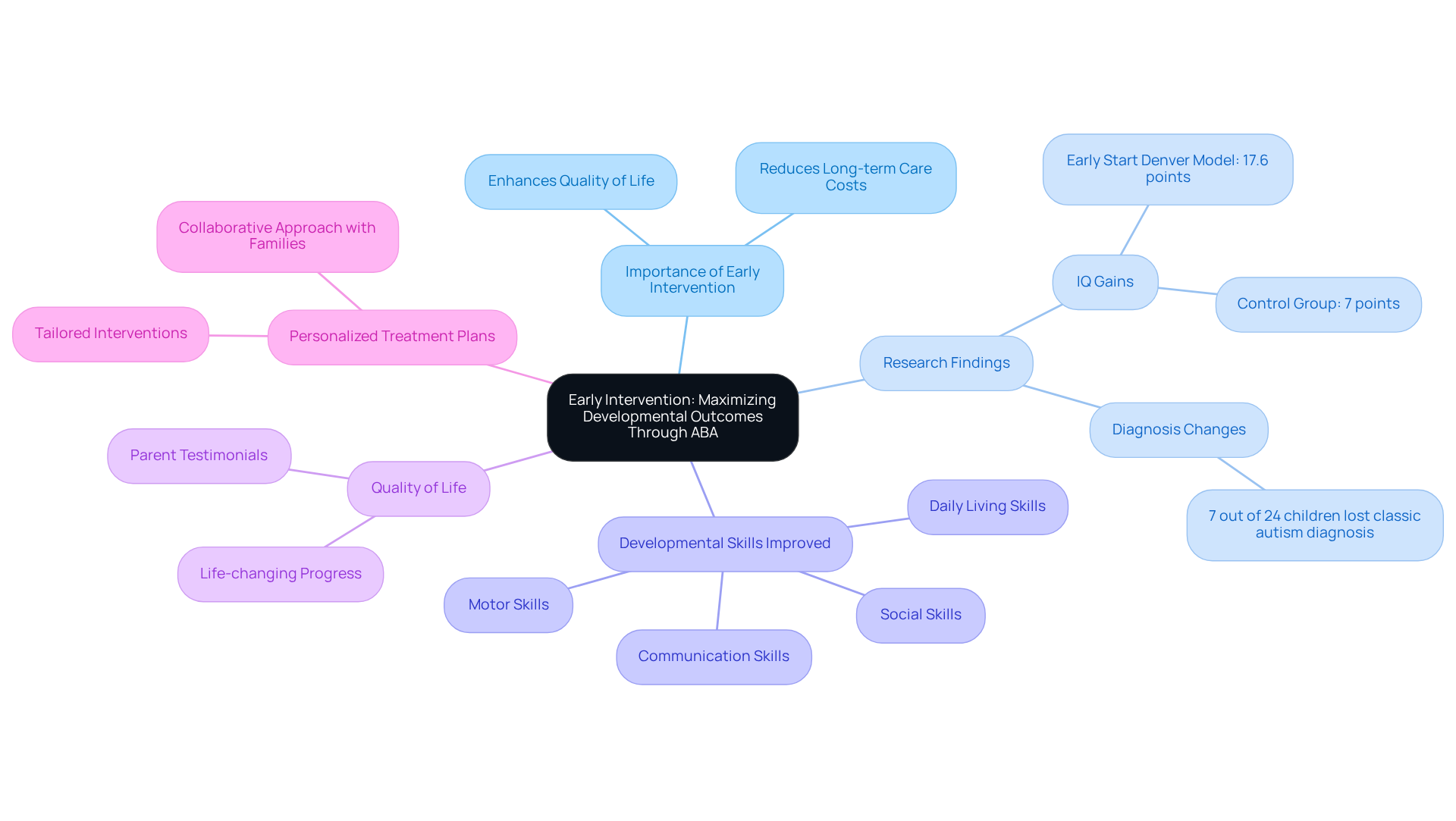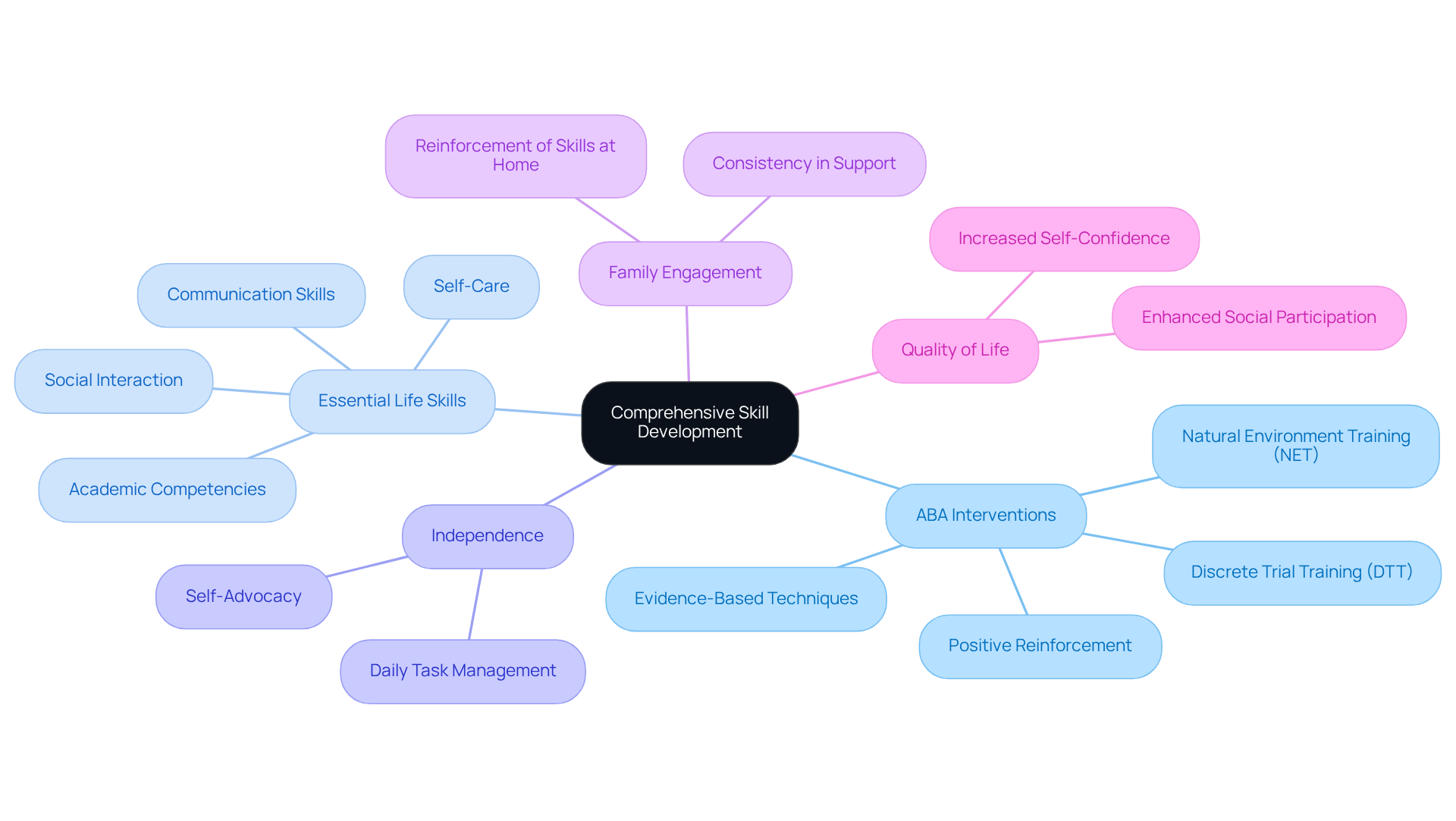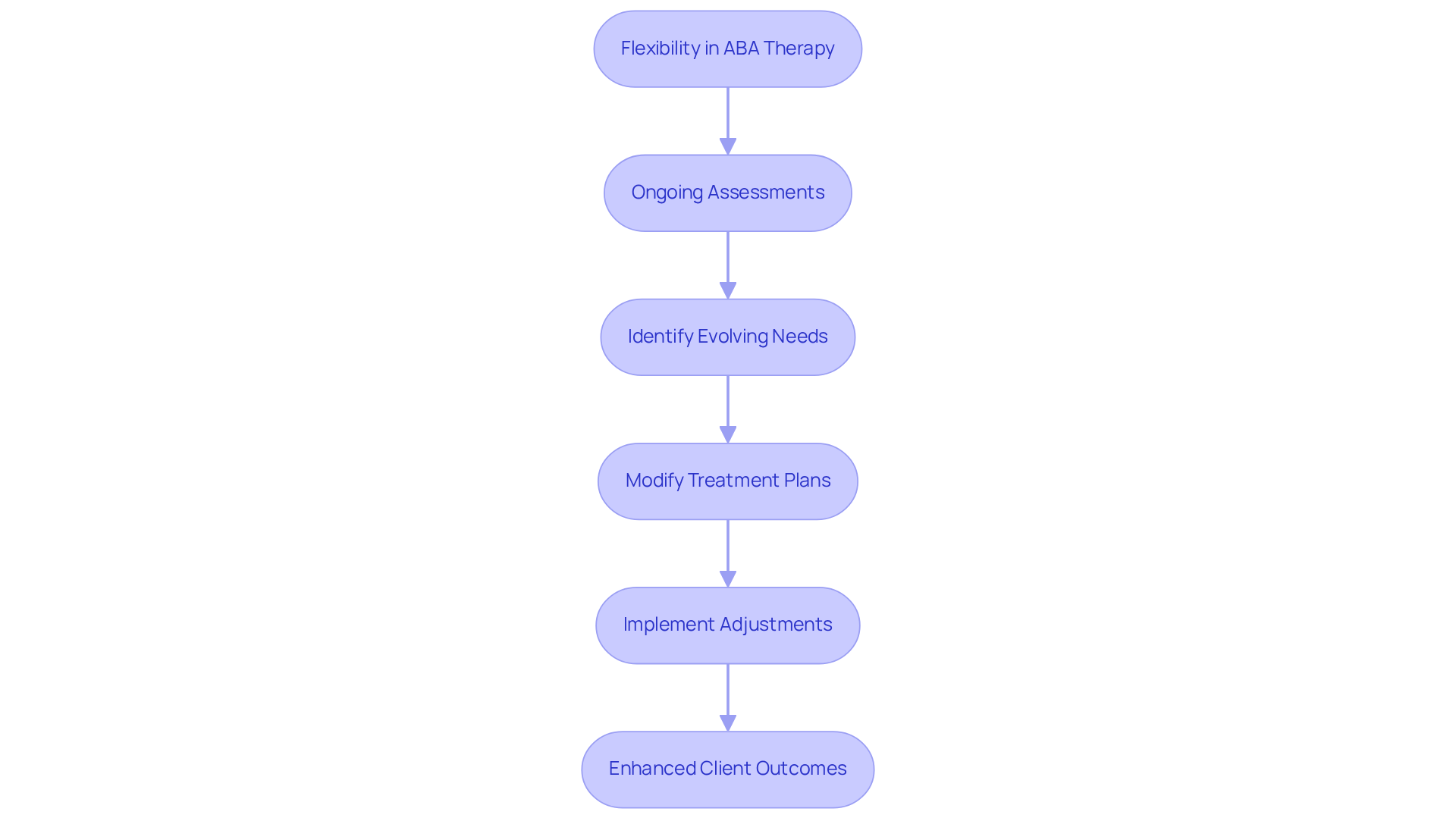September 28, 2025

This article highlights the significant advantages of ABA therapy for healthcare employers in New York City, illustrating how these benefits can elevate service delivery and improve patient outcomes. With the growing demand for Board Certified Behavior Analysts (BCBAs), it is crucial to consider how effective recruitment strategies can transform your practice. Key benefits include:
These elements are essential for implementing effective ABA therapy practices and ensuring comprehensive care for individuals with autism and related disorders.
Are you facing challenges in attracting qualified professionals? By utilizing Hire ABA for recruitment, you can enhance your team's capabilities and ultimately provide better care. Improved recruitment strategies not only streamline the hiring process but also ensure that you have the right talent to meet the needs of your patients.
In conclusion, leveraging the advantages of ABA therapy and effective recruitment can lead to superior outcomes for your organization and those you serve. Consider Hire ABA as your trusted partner in navigating these challenges and enhancing your service delivery.
The landscape of healthcare in New York City is rapidly evolving, particularly in the realm of Applied Behavior Analysis (ABA) therapy. With a projected 25% increase in demand for Board Certified Behavior Analysts (BCBAs) by 2026, healthcare employers face an urgent need to refine their recruitment strategies to attract and retain top talent.
This article delves into the myriad benefits of ABA therapy for healthcare employers.
These factors not only enhance patient outcomes but also streamline hiring processes. However, amidst this growing demand, how can employers effectively navigate the complexities of recruitment while ensuring the highest quality of care?
Consider how Hire ABA can help address these challenges and elevate your hiring strategy.
The demand for Board Certified Behavior Analysts (BCBAs) is projected to surge by 25% by 2026. With job postings expected to rise from approximately 34,000 in 2020 to 103,150 by 2024, the need for effective recruitment strategies has never been more critical. Hire ABA is a dedicated recruitment platform that connects BCBAs with premier job opportunities in the rapidly expanding field of ABA therapy NYC.
But how can healthcare employers navigate this competitive landscape? Hire ABA streamlines the hiring process, helping job seekers locate opportunities that align with their skills and career objectives. The platform offers tailored resume evaluations, assessing candidates' experiences and ambitions to ensure they are well-prepared for the job market.
By utilizing advanced job fit scoring, Hire ABA matches candidates with opportunities that reflect their skills, preferences, and desired locations. This comprehensive support allows healthcare employers to swiftly identify and recruit qualified talent, addressing the urgent need for skilled professionals. It is important to note that nearly 50% of BCBAs leave their positions within the first two years, often due to weak support from management and lack of competitive pay.
Effective recruitment strategies are vital for retaining these professionals and ensuring continuity of care. By choosing Hire ABA therapy NYC, you not only gain access to a pool of qualified candidates but also contribute to improved patient care for those needing ABA support. Are you ready to elevate your hiring process? Trust Hire ABA to connect you with the talent you need to succeed.

Customized treatment plans are essential to the success of ABA therapy NYC interventions, ensuring that strategies are specifically tailored to meet the unique needs of each individual. These plans are crafted through thorough assessments that evaluate the individual's strengths, challenges, and specific goals. Notably, studies show that the overall success rate for addressing autism with ABA is 89%. Clients report considerably enhanced results in communication, social abilities, and independence. By tailoring therapy, practitioners effectively tackle behavioral issues by comprehending the purpose of behavior, fostering development, and resulting in increased engagement and ownership in the treatment process.
Behavior analysts emphasize that tailoring interventions not only improves therapeutic effectiveness but also fosters a collaborative environment where families are actively involved—crucial for sustainable progress. Effective tailored ABA therapy NYC interventions, which employ evidence-based methods like Pivotal Response Training (PRT) and Natural Environment Teaching (NET), have shown significant improvements in essential abilities. This highlights the importance of customization in attaining substantial advancement for clients.
Healthcare employers are encouraged to consider implementing personalized ABA therapy NYC plans in their practices to maximize treatment effectiveness. Are you facing challenges in your current hiring process? Reflect on how tailored approaches can enhance your recruitment efforts. By prioritizing customized plans, you can ensure a more effective and collaborative treatment experience.

ABA treatment is firmly rooted in evidence-based practices that have undergone extensive scientific validation. Research consistently indicates that ABA interventions lead to significant improvements in communication, social skills, and adaptive behaviors among individuals with autism and related developmental disorders. For instance, studies reveal that 47% of children undergoing ABA treatment become indistinguishable from their peers, with an impressive overall success rate of 89% in addressing autism. Furthermore, when recommended hours are fully implemented with active caregiver participation, 90% of individuals achieve remarkable progress.
By implementing these evidence-based methods, healthcare employers can ensure their ABA therapy NYC programs are not only effective but also aligned with the highest standards of practice in the field. This ultimately fosters better outcomes for those they serve. The adaptability of ABA therapy NYC approaches allows for personalized plans that address the distinct requirements of every client, integrating initial evaluations and family participation to enhance the effectiveness of interventions.
Are you facing challenges in hiring qualified professionals for your ABA programs? Consider how utilizing Hire ABA for recruitment can streamline your process and ensure you attract the best talent in the field. With the right support, your organization can thrive and make a profound impact on the lives of those you serve.

Early intervention through ABA treatment is crucial for optimizing developmental outcomes in children with autism and related disorders. Research consistently demonstrates that initiating ABA intervention at a young age can lead to significant improvements in communication, social skills, and overall functioning.
For example, a study revealed that children in the Early Start Denver Model treatment group experienced an average gain of 17.6 IQ points, compared to only 7 points in the control group, underscoring the effectiveness of early intervention.
By tackling developmental challenges early, healthcare providers can facilitate the achievement of critical milestones, establishing a robust foundation for future success. This proactive strategy not only enhances the child's quality of life but also diminishes long-term care costs for families and healthcare systems, positioning it as a strategic investment in public health.
Furthermore, personalized treatment plans, as emphasized by LittleStar, are vital in customizing interventions to meet each child's unique needs, thereby improving outcomes. It is essential to recognize that while early intervention is paramount, ABA techniques can benefit individuals of all ages, dispelling the misconception that it is solely suitable for young children.

The participation of relatives in ABA intervention is crucial for enhancing treatment results, cultivating a cooperative atmosphere between practitioners and families. Involving households in the therapeutic process guarantees steady reinforcement of skills at home, which is essential for the generalization of acquired behaviors. Notably, studies indicate that individuals participating in group counseling sessions achieve a treatment completion rate of 83.2%, compared to just 59.2% for those not involved. This underscores the significant influence of familial involvement on treatment success.
Furthermore, patients receiving group therapy attend a higher percentage of sessions, with median attendance rates of 84.38% versus 75.00% for those not receiving group therapy. When families actively engage, they provide valuable insights into their child's needs, preferences, and progress, enabling therapists to customize treatment plans more effectively. This collaboration not only fortifies the therapeutic alliance but also empowers families to support their child's development, leading to enhanced communication, improved social skills, and reduced challenging behaviors.
Moreover, therapists report that the involvement of relatives correlates with lower dropout rates, reinforcing the notion that a cohesive strategy among household members is vital for achieving significant advancements in ABA therapy NYC. To promote family involvement, healthcare employers should facilitate open dialogue between therapists and families regarding progress in ABA treatment.

ABA intervention is meticulously designed to promote thorough abilities development, emphasizing essential life competencies that enable individuals to navigate daily challenges effectively. Did you know that approximately 70% of clients achieve independence in daily tasks through tailored ABA interventions? This statistic underscores the effectiveness of this evidence-based practice. Through structured interventions, therapists convey essential abilities such as communication, social interaction, self-care, and academic competencies. By breaking down complex tasks into manageable steps, ABA methods not only enhance independence but also significantly improve the overall quality of life for clients.
As Dr. Doreen Granpeesheh observes, 'ABA is a science-driven method that aims to comprehend behaviors and utilizes evidence-based techniques to impart new abilities,' ultimately boosting independence and enhancing quality of life. Furthermore, family engagement is essential in strengthening the skills acquired during treatment, ensuring consistency and support in the client's surroundings.
Consider how ABA therapy NYC can assist in addressing your hiring challenges and ensuring the best outcomes for your clients.

Flexibility is essential to the effectiveness of ABA therapy NYC practices. It allows practitioners to customize interventions according to the evolving needs of their clients. As individuals progress, their goals and challenges may shift, necessitating timely adjustments to treatment plans. This dynamic approach ensures that interventions remain relevant and impactful, ultimately enhancing client outcomes.
In environments such as schools and homes, where demands can vary significantly, the ability to adapt is crucial. Research indicates that children receiving personalized ABA treatment demonstrate improved adaptive behaviors, with effect sizes for adaptive behavior interventions reported at 0.422. Therapists employ ongoing assessments, including methodologies like Interview-Informed Synthesized Contingency Analysis (IISCA), which shows an impressive 88% success rate when blended with traditional ABA. This strategy modification ensures that each treatment plan is tailored to address specific triggers and needs.
Successful adaptations in ABA interventions not only foster skill development but also empower clients to navigate their environments more effectively. This reinforces the importance of flexibility in achieving long-term success. Are you considering how to enhance your practices in ABA therapy NYC? Embrace flexibility to ensure that your interventions remain impactful and relevant.

Collaborative care in ABA therapy NYC employs a team-oriented strategy that unites behavior analysts, therapists, educators, and relatives. This multidisciplinary collaboration effectively addresses all facets of a client's needs, including ABA therapy NYC, resulting in comprehensive and impactful treatment.
Research shows that when caregivers are actively involved, an impressive 90% of individuals demonstrate significant progress. This statistic underscores the essential role of teamwork in achieving positive outcomes. By sharing insights, strategies, and resources, team members elevate the quality of care provided.
This collaborative model not only enhances treatment outcomes but also cultivates a supportive environment for clients and their families, particularly in the context of ABA therapy NYC. Furthermore, a study revealed that after implementing a hybrid ABA treatment model, 41.8% of goals exhibited improvement, further highlighting the effectiveness of collaborative efforts.
The integration of technology streamlines communication and data tracking. A case study on "Technology Integration in ABA Therapy" illustrates how technology enhances data collection, enabling personalized care plans tailored to each client's specific needs.
Ultimately, the synergy generated through team-based assistance in ABA therapy NYC leads to significant advancements in behavioral health, ensuring that clients receive the best possible care.

A fundamental objective of ABA treatment is to cultivate independence in individuals with autism and related disorders. By imparting essential life skills such as dressing, grooming, and managing household chores, and encouraging adaptive behaviors, ABA support empowers clients to tackle daily challenges with confidence.
Research indicates that individuals involved in ABA treatment often show remarkable enhancements in their ability to manage daily tasks, communicate effectively, and engage socially. Notably, 90% of individuals with autism demonstrate significant improvement when recommended hours of ABA support are fully implemented with engaged caregiver participation.
The long-term benefits of ABA therapy NYC not only elevate the quality of life for clients but also diminish the necessity for continuous support, ultimately fostering greater independence.
Furthermore, behavior analysts have observed that the customized approach of ABA intervention, which incorporates strategies like task analysis and positive reinforcement, plays a vital role in assisting individuals to master daily living skills, such as money management and community navigation, thereby enhancing their self-sufficiency and confidence in maneuvering the world around them.
Family participation is equally crucial, as caregivers are instructed in methods to support learning beyond treatment, reinforcing the skills acquired during ABA therapy NYC sessions.

Accessing ABA therapy NYC support services is paramount for individuals and households seeking assistance for autism and related disorders. A multitude of resources is available, including specialized clinics, private practitioners, and community organizations committed to offering ABA therapy NYC. Notably, approximately 30% of households report facing significant challenges in securing these vital services, underscoring the urgent need for improved support systems.
As Temple Grandin poignantly stated, "I am different, not less," which highlights the critical nature of these services for individuals on the spectrum. Healthcare employers have a crucial role in enhancing accessibility by providing information about available services and aiding clients in navigating the healthcare system. Furthermore, understanding insurance coverage and reimbursement options is essential, as it profoundly impacts households' ability to access necessary assistance.
By promoting awareness and facilitating connections, healthcare employers can ensure that individuals receive the comprehensive care they need to flourish. Additionally, healthcare employers can implement actionable strategies, such as:

The significance of ABA therapy in healthcare settings, particularly in New York City, is paramount. With the demand for Board Certified Behavior Analysts (BCBAs) escalating, healthcare employers must prioritize effective recruitment strategies and personalized treatment plans to ensure the highest quality of care. By leveraging platforms like Hire ABA, employers can streamline their hiring processes and connect with qualified professionals equipped to deliver tailored interventions that meet the unique needs of each client.
Key benefits of ABA therapy include:
These elements not only enhance treatment outcomes but also foster a collaborative environment that empowers individuals with autism and related disorders. The flexibility of ABA therapy allows practitioners to adapt interventions as clients progress, ensuring continued relevance and effectiveness in addressing their evolving needs.
Integrating ABA therapy into healthcare practices represents a profound opportunity to improve the lives of individuals with autism and related disorders. By embracing personalized approaches, engaging families, and utilizing collaborative care models, healthcare employers can significantly enhance the effectiveness of their services. As the landscape of ABA therapy continues to evolve, taking proactive steps to improve accessibility and support systems will be crucial in ensuring that all individuals receive the comprehensive care they deserve.
What is Hire ABA and what does it offer?
Hire ABA is a dedicated recruitment platform that connects Board Certified Behavior Analysts (BCBAs) with job opportunities in the field of ABA therapy, specifically in NYC. It streamlines the hiring process for healthcare employers and helps job seekers find positions that match their skills and career goals.
Why is there a growing demand for BCBAs?
The demand for BCBAs is projected to surge by 25% by 2026, with job postings expected to increase from approximately 34,000 in 2020 to 103,150 by 2024. This growth highlights the critical need for effective recruitment strategies in the field.
How does Hire ABA assist job seekers?
Hire ABA offers tailored resume evaluations to assess candidates' experiences and ambitions. It utilizes advanced job fit scoring to match candidates with opportunities that align with their skills, preferences, and desired locations.
What challenges do BCBAs face that impact retention?
Nearly 50% of BCBAs leave their positions within the first two years, often due to inadequate support from management and lack of competitive pay. Effective recruitment strategies are essential for retaining these professionals.
What is the success rate of ABA therapy?
Studies show that the overall success rate for addressing autism with ABA therapy is 89%. Clients report significant improvements in communication, social skills, and independence.
How are personalized treatment plans developed in ABA therapy?
Customized treatment plans are created through thorough assessments that evaluate an individual's strengths, challenges, and specific goals, ensuring strategies are tailored to meet their unique needs.
What evidence supports the effectiveness of ABA therapy?
Research consistently shows that ABA interventions lead to significant improvements in communication, social skills, and adaptive behaviors among individuals with autism and related developmental disorders, with a success rate of 89%.
How can healthcare employers enhance their ABA programs?
Healthcare employers are encouraged to implement personalized ABA therapy plans to maximize treatment effectiveness and foster a collaborative environment involving families, which is crucial for sustainable progress.
What role does caregiver participation play in ABA therapy outcomes?
When recommended hours of ABA treatment are fully implemented with active caregiver participation, 90% of individuals achieve significant progress.
How can Hire ABA improve the hiring process for healthcare employers?
By utilizing Hire ABA for recruitment, healthcare employers can streamline their hiring process, ensuring they attract qualified professionals who can contribute to effective ABA therapy programs.
Our expert recruitment strategies and AI-driven sourcing ensure that you receive top-notch candidates quickly, without compromising on quality. Whether you’re looking for BCBAs, Clinical Directors, or RBTs, we’ve got you covered.